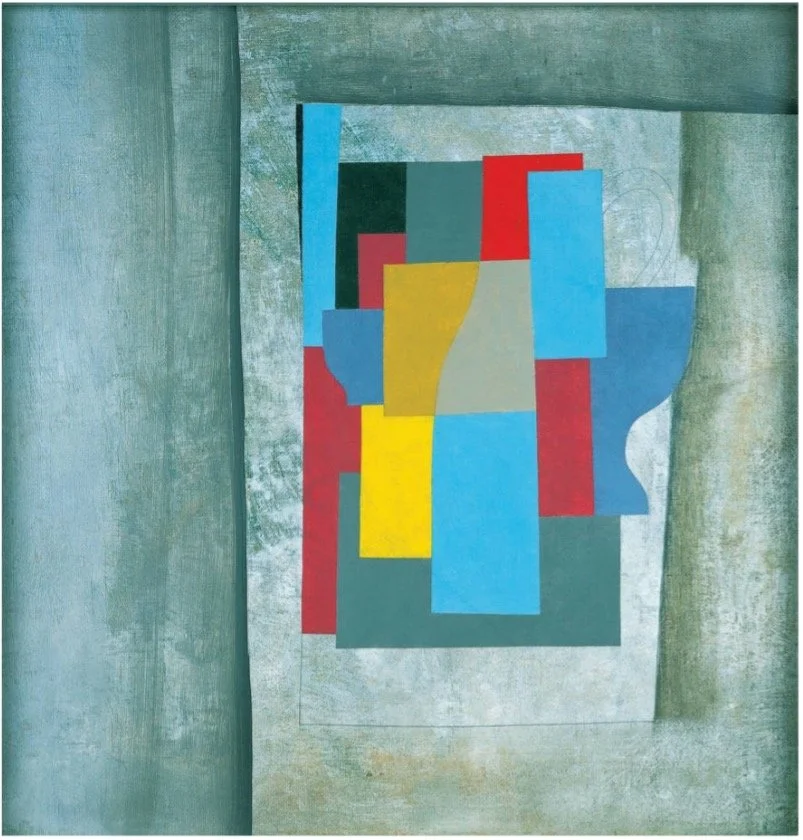Ben Nicholson 1894–1982
By Sophie Turner
Ben Nicholson, 1946 (still life – cerulean), 1946, Oil on canvas over board, 64 x 63 cm, Pallant House Gallery, Chichester.
Once considered the leading figure of British Modernism, Ben Nicholson’s commitment to Cubist abstraction cemented him as a central player in bringing European abstraction to England. However, in recent years, his second wife Barbara Hepworth is now named as an example of the quintessence of the twentieth century British art, while Nicholson is often overlooked.
Nicholson was born on the 10th April, 1894 into a family of painters, he continued this tradition by marrying his first wife, the artist Winifred Nicholson. The couple’s modern approach saw Nicholson reject his father Edwardian style, instead seeking inspiration in European avant-guard movements. After a brief period of experimentation with artistic practices inspired by the Post-Impressionists, Nicholson’s early still life paintings embrace a flattening of form, with a focus upon line and shape inspired by Picasso and other Cubists. The simplification of design and scraping back of paint, using a palette knife, leaves the painting with naïve, rustic finish.
During the 1930s, Nicholson had an affair with Hepworth, joining her in her Hampstead studio and eventually marrying her after his divorce to Winifred. Hampstead during the 1930s remained a hub of artistic activity; this surrounding influence led Nicholson to develop a geometric abstract style that he is most known for. Whilst his paintings remained informed by abstraction, it was not till after he visited Piet Mondrian’s studio that he jettisoned all recognisable subject matter and started working solely with simple geometric forms. Additionally, arguably inspired by Hepworth’s sculptural practice, Nicholson started carving geometric abstract reliefs that were austerely painted white.
With the outbreak of war in 1939, Nicholson and Hepworth moved their family from London to St Ives, Cornwall. The change in location with St Ives’ famous light and picturesque landscape influenced Nicholson’s artistic practice. The biographer and critics of Nicholson’s work, Jeremy Lewison, has argued that his ‘disciplined line carved open the picture space, which he filled with light and colour based on his perception of the environment’. This is evident within 1946 (still life – cerulean) that represents bottles, cups, and goblets through Cubist-inspired plains of colour. Yet, the intense cerulean blue, referenced in the work’s title, has been taken as an allusion to the vivid colour of the Cornish Sea. The suggestion of a curtain on the left of the image suggests an interplay between Nicholson’s painted indoor scene and his surrounding outdoor environment, not previously visible within his London paintings. This lead to the development of what Nicholson named still life-landscapes, that presented abstract still lifes alongside Cubist, naïve landscapes.
Nicholson established the Penwith Society of Art in Cornwall in 1949, making a name for the fishing-town of St Ives as a leading community of modern artists. After the war, Nicholson gained critical acclaim for both his practice and support of the arts. His work was widely celebrated: winning the International Guggenheim Painting Competition, representing Britain at the Venice Biennale and was the subject of a retrospective exhibition at the Tate Gallery. Nicholson’s marriage with Hepworth ended in 1951; he married again in 1958 and lived in Switzerland, Cambridge, and London before his death in 1982.
Whilst Nicholson’s name may now appear on a dusty list of early twentieth century artists, his developments in abstraction should be remembered as crucial in the development of British art within the twentieth century.
Bibliography
“Ben Nicholson and Still Life”, Pallant Gallery, https://pallant.org.uk/ben-nicholson-and-still-life/ [date accessed: 2nd April 2022].
“Ben Nicholson”, Kettle’s Yard, https://www.kettlesyard.co.uk/collection-item/musical-instruments/ [date accessed: 2nd April 2022].
Charles Harrison, “Notes on Ben Nichsolson’s development and commentary on selected works” in Ben Nicholson” in Ben Nicholson: [catalogue of an exhibition at] the Tate Gallery: 19 June - 27 July 1969 (London: Tate Gallery, 1969).
Virginia Button, Ben Nicholson: St Ives Artists (London: Tate Publishing, 2007).

